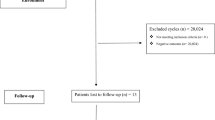Abstract
Purpose
To investigate the incidence of Tubal Ectopic Pregnancies (TEP) in IVF-ET patients with respect to the status of the fallopian tubes after a previous TEP.
Material and methods
This retrospective study compares patients undergoing 481 IVF-ET cycles after conservatively or surgically treated TEP(s) with a Control Group (idiopathic or male factor for IVF-ET indication). Medical reports of surgery and/or hysterosalpingograms prior to the IVF cycles classified the status of the fallopian tubes.
Results
12 TEPs (8.95%/Pregnancies (PR)) occurred in the Study Group. In the Control Group one TEP (0.75%/PR; p < 0.001) was found. Smoking increased the probability of TEPs (p = 0.0028) and of pathological pregnancies (abortion, biochemical and ectopic PR; (p = 0.0411)). For statistic evolution logistic regression (PROC GENMOD) and a repeated measure model were applied.
Conclusion
Women with a previous TEP should be informed about the significantly increased risk for a further TEP in IVF-ET treatment, especially if they are smoking.
Similar content being viewed by others
References
Katz E, Akman M, et al. Deleterious effect of the presence of hydrosalpinx on implantations and pregnancy rates with in vitro fertilization. Fertil Steril 1996;66:122–5.
Cohen M, Lindheim S, et al. Hydrosalpinges adversely affect implanation in donor oocyte cycles. Hum Reprod Engl 1999;14(4):1087–9. doi:10.1093/humrep/14.4.1087.
Camus E, Poncelet C, et al. Pregnancy rates after in vitro fertilization in cases of tubal infertility with and without hydrosalpinx: a meta-analysis of published comparative studies. Hum Reprod 1999;4(5):1243–9. doi:10.1093/humrep/14.5.1243GB.
Ankum W, Mol B, et al. Risk factors for ectopic pregnancy, a meta-analysis. Fertil Steril 1996;65(6):1093–9.
Parazzini F, Tozzi L, et al. Risk factors of ectopic pregnancy: An Italian case control study. J Obstet Gyn 1992;80(5):821–6.
Coste J, Job-Spira N, Fernandez H. Increased risk of ectopic pregancy with maternal cigarette smoking. Am J Public Health 1991;81(2):199–201.
Zouves C, Erenus M, et al. Ectopic pregnancy after in vitro fertilization and embryo transfer: a role for proximal occlusion or salpingectomy after failed distal tubal surgery? Fertil Steril 1991;56(4):691–5.
Dubuisson J, Aubriot F, et al. Risk factors of ectopic pregnancy in 556 pregnancies after in vitro fertilization: implications for preventive management. Fertil Steril 1991;56(4):686–90.
Clayton H, Schieve L, Peterson H, Jamieson D, Reynolds M, Wright V. Ectopic Pregnancy Risk With Assisted Reproductive Technology Procedures. Obstet Gynecol 2006;107(3):595–604.
Kemeter P, Feichtinger W. Experience with a new fixed-stimulation protocol without hormone determinations for programmed oozyte retrieval for IVF. Hum Reprod 1989;4:53–8.
Macnamee C, Howles C, et al. Short luteinizing hormone- releasing agonist treatment: prospective trial of a novel ovarian stimulation regimen for in- vitro fertilization. Fert Ster. 1989;89–92.
Tan S, Kingsland C, et al. The long protocol of administration of gonadotropin—releasing hormone agonist is superior to the short protocol for ovarian stimulation for in- vitro fertilization. Fertil Steril 1992;57:810–4.
Deutsches IVF-Register; Jahresbericht 2006, p12
Clayton H, Schieve L, et al. Ectopic Pregnancy Risk With Assisted Reproductive Technology Procedures. Obstet Gynecol 2006;107(3):595–604.
Qublan H, Malkawi H, et al. In-vitro fertilisation treatment: factors affecting its results and outcome. J Obstet Gynaecol 2005;25(7):689–93. doi:10.1080/01443610500292353.
Verhulst G, Camus M, et al. Analysis of risk factors with regard to the occurrence of ectopic pregnancy after medically assisted procreation. Hum Reprod 1993;8(8):1284–7.
Serour G, Aboulghar M, et al. Complications of medically assisted conception in 3.500 cycles. Fertil Ster USA 1998;70(4):638–42. doi:10.1016/S0015-0282(98)00250-7.
Hajenius P, Mol F, et al. Interventions for tubal ectopic pregnancy. Cochrane Database Syst Rev 2007. (1):CD000324.
Bulletti C. de Ziegler; Uterine contractility and embryo implantation. Curr Opin Obstet Gynecol 2005;17(3):265–76. doi:10.1097/01.gco.0000169104.85128.0e, Review.
Lyons R, Saridogan E, et al. The effect of ovarian follicular fluid and peritoneal fluid on Fallopian tube ciliary beat frequency. Hum Reprod 2006;21(1):52–6. doi:10.1093/humrep/dei306.
Lyons RA, Djahanbakhch O, et al. Peritoneal fluid, endometriosis, and ciliary beat frequency in the human fallopian tube. Lancet 2002;360(9341):1221–2. doi:10.1016/S0140-6736(02)11247-5.
Feichtinger W, Papalambrou K, et al. Smoking and In Vitro Fertilization: A Meta-Analysis. J Assist Reprod Genet 1997;14:596–9. doi:10.1023/A:1022584802711.
Agarwal S, Wisot A, et al. Cornual pregnancies in patients with prior salpingectomy undergoing IVF-ET. Fertil Steril 1996;65(3):659–60.
Nazari A, Askari H, et al. Embryo transfer technique as a cause of ectopic pregnancy in In- vitro fertilization. Fertil Steril 1993;60(5):919–21.
Pope C, Cook E, et al. Influence of embryo transfer depth on in vitro fertilization and embryo transfer outcomes. Fertil Steril 2004;81(1):51–8. doi:10.1016/j.fertnstert.2003.05.030.
Author information
Authors and Affiliations
Corresponding author
Additional information
Capsule Tubes after a Tubal ectopic pregnancy (TEP) and smoking lead to a significant higher number of repeated TEPs in following IVF-ET programs.
Rights and permissions
About this article
Cite this article
Weigert, M., Gruber, D., Pernicka, E. et al. Previous tubal ectopic pregnancy raises the incidence of repeated ectopic pregnancies in In Vitro fertilization-embryo transfer patients. J Assist Reprod Genet 26, 13–17 (2009). https://doi.org/10.1007/s10815-008-9278-2
Received:
Accepted:
Published:
Issue Date:
DOI: https://doi.org/10.1007/s10815-008-9278-2




